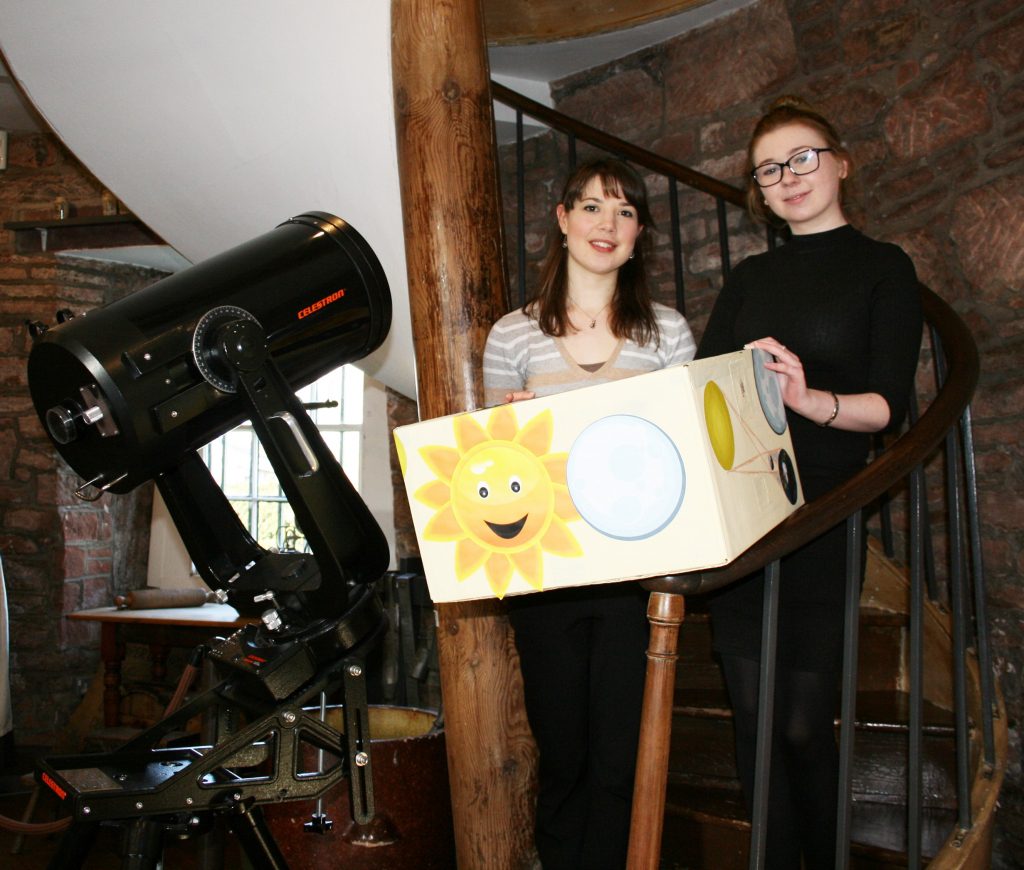Dumfries Museum has teamed up with Dumfries Astronomy Society for Solar Eclipse events to coincide with the BBC’s Stargazing LIVE project and live television programmes – a nationwide campaign to get people exploring and learning about the sky above them.
 A total solar eclipse will occur in the Northern hemisphere on Friday 20 March. It is the last total solar eclipse visible in Europe until 2026. In Dumfries we can expect to see 85-95% of the suns light blocked out by the shadow of the moon. The blackout will happen from 8.30am, with the maximum eclipse (when the moon is nearest the middle of the sun) at around 9.30am. It will come to an end at 10.43am.
A total solar eclipse will occur in the Northern hemisphere on Friday 20 March. It is the last total solar eclipse visible in Europe until 2026. In Dumfries we can expect to see 85-95% of the suns light blocked out by the shadow of the moon. The blackout will happen from 8.30am, with the maximum eclipse (when the moon is nearest the middle of the sun) at around 9.30am. It will come to an end at 10.43am.
A solar eclipse occurs when the Moon passes between Earth and the Sun, totally or partly obscuring the image of the Sun for a viewer on Earth. A total solar eclipse occurs when the Moon’s apparent diameter is larger than the Sun, blocking all direct sunlight, turning day into darkness. Totality occurs in a narrow path across Earth’s surface, and a partial solar eclipse will be visible over a region thousands of kilometres wide.
Councillor Tom McAughtrie said: “There won’t be another solar eclipse that can be seen from Scotland for another 11 years. These events at Dumfries museum are a great opportunity for our community to come together and experience this rare phenomenon.”
Looking directly at the sun can seriously harm your eyes. Binoculars and telescopes should never be used to view the sun unless fitted with special solar filters.
On Thursday 19 March 6.30-8.30pm at Dumfries Museum, join members of the Dumfries Astronomy Society and museum volunteers to learn more about solar eclipses and how to view them safely. There will be hands on activities for children, stargazing with the astronomers and light refreshments will be available.
On Friday 20 March 8.30 – 10.30am, as the moon and sun align and the world grows unusually dark come along to Dumfries Museum for a community eclipse viewing. Conditions permitting  (weather and the height of the sun in the sky) the Camera Obscura may be used to see a projected view of the early stages of the eclipse. Other safe methods of viewing the eclipse will also be available (you can use your solar observer made on Thursday evening).
(weather and the height of the sun in the sky) the Camera Obscura may be used to see a projected view of the early stages of the eclipse. Other safe methods of viewing the eclipse will also be available (you can use your solar observer made on Thursday evening).
If you plan to bring a group or school party to this event please call the museum in advance so that we can arrange best use of the Camera Obscura (Tel 01387 253374).
Photo’s attached: . Kayleigh Scott and Louise Donoghue check out the preparations for eclipse viewing at Dumfries Museum and Camera Obscura.





